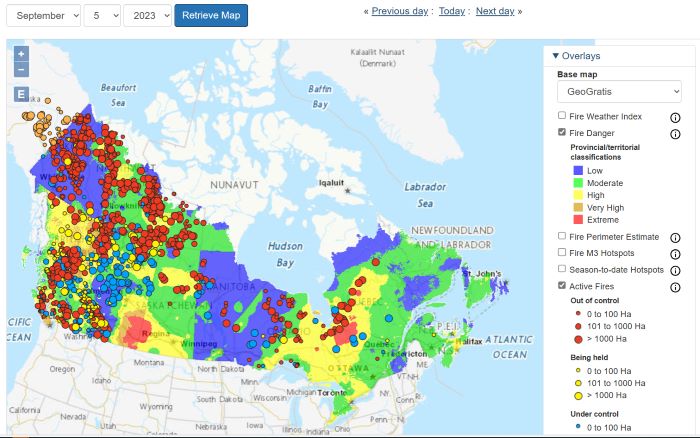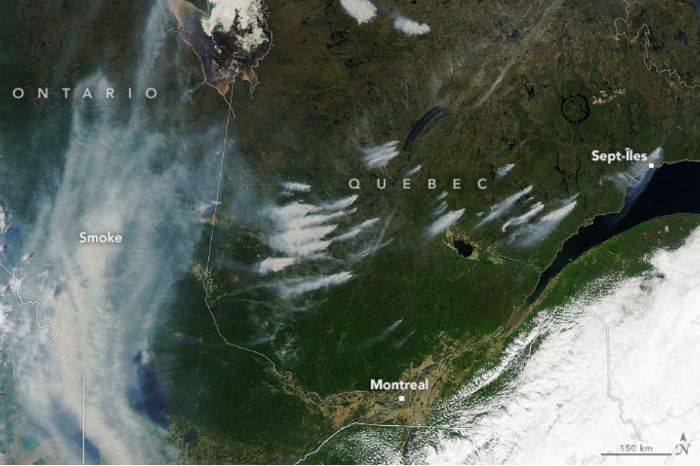In 2023, Canada faced a formidable challenge: record-breaking wildfires. These fires were fuelled by record high temperatures and widespread drought conditions across the country. To what extent can climate change be linked to these events? Scientists from around the world did a rapid turn-around study to find answers.
The 2023 experience:
Canada’s 2023 wildfire season was the most destructive ever recorded. By the end of the year, more than 6,000 fires had torched a staggering 15 million hectares of land. To put that in perspective, that’s an area larger than England and more than double the 1989 record. Normally, an average of 2.5 million hectares of land are consumed in Canada every year. And unlike previous years, the fires this year were widespread, from the West Coast to the Atlantic provinces, and the North. By mid-July, there were 29 mega-fires, each exceeding 100,000 hectares.

Screen grab from NRCan’s interactive map showing active fires as of September 5, 2023.
“The word ‘unprecedented’ doesn’t do justice to the severity of the wildfires in Canada this year,” says Yan Boulanger, research scientist in forest ecology at Natural Resources Canada. “From a scientific perspective, the doubling of the previous burned area record is shocking.”
Yan and two other Canadian Forest Services scientists — Jonathan Boucher and Sandy Erni — were part of an international team of 16 scientists involved in a rapid research study focused on Quebec’s wildfire season. The team found that climate change more than doubled the likelihood of extreme fire weather conditions in Quebec.
The study was conducted by World Weather Attribution (WWA), a group that looks at how climate change affects the intensity and likelihood of an extreme weather event. These studies are done very quickly, and while it’s important to note that this report hasn’t been peer reviewed yet, the study used peer-reviewed methods.

June 3, 2023 — The Moderate Resolution Imaging Spectroradiometer (MODIS) on NASA’s Aqua satellite captured this view of smoke billowing from Quebec fires on June 3. On June 1 more than 120 fires were ignited in a single day, and as of June 5, more than 150 wildfires were active in Quebec. (NASA Earth Observatory image of the Quebec wildfires by Lauren Dauphin, using MODIS data from NASA EOSDIS LANCE and GIBS/Worldview)
Why study Quebec? Well, Canada is so big that it’s difficult to gather data from across all time zones to capture data across the country from coast to coast in a timely manner. Also, Quebec had an early start to the devastating 2023 wildfire season. Warm and dry conditions appeared in early May, setting the stage for June and July. On June 1, more than 120 fires were ignited by lightning in just one day. “Climate change is greatly increasing the flammability of the fuel available for wildfires because the trees, fallen trees, and underbrush are all so dry,” explains Yan. “This means that a single spark, regardless of its source, can rapidly turn into a blazing inferno.”
From June 1 to 25, more land burned in southern Quebec than in the previous 20 years combined. These conditions led to the largest single fire ever recorded in southern Quebec, which consumed 460,000 hectares. With all this, it’s no wonder scientists are trying to find out what’s going on.
Researchers used Natural Resources Canada’s Fire Weather Index (FWI), a metric that combines temperature, windspeed, relative humidity and precipitation to estimate the level of fire danger. To assess the effect of hot and dry weather conditions from January to July, the scientists also calculated the Cumulative Daily Severity Rating from the FWI.

Aftermath of a wildfire near Kelowna, B.C. This year’s fire activity could also impact forest carbon balance, biodiversity, and disrupt local businesses, forest sector economies and Indigenous communities. (photo: Getty Images)
The role of climate change
“There’s no question, extreme weather, record high temperatures and dry conditions caused by climate change intensified this year's wildfire crisis,” says Jonathan.
Canada experienced its warmest May to July period in over 80 years, breaking previous national temperature records for the two-month period by 0.8°C. To quantify the effect of climate change on weather, scientists used weather data and computer model simulations to compare the pre-industrial climate to today’s conditions, after about 1.2°C of global warming since the late 1800s. The study found that climate change made the extreme intensity of this fire season at least two times more likely than under preindustrial climate while the persistence of these conditions were at least seven times more likely. Furthermore, they found that wildfire-prone weather conditions in Quebec were 50 percent more intense because of climate change caused by human activity, while the peak intensity recorded was 20 percent higher.
Assessing events such as wildfires and weather presents a unique challenge. Jonathan emphasizes the need to constantly update climate models to account for ever-evolving weather patterns. “For instance, this summer’s record temperatures and low humidity in Quebec was extreme by today’s standards,” he says. “But they could be the norm by the end of the century.”
Long-term consequences:
The increasing risk of wildfires highlighted by the WWA study raises some key questions: How do we prepare? How do we adapt? What about wildfire response, containment and recovery? The WWA publishes results soon after the event, instead of waiting for a long review process, so they can provide context and lessons learned quickly after an extreme event.
This year’s fire activity could also impact forest carbon balance, biodiversity, and disrupt local businesses, forest sector economies and Indigenous communities.
Looking ahead:
As wildfire risks will continue to intensify as the climate warms, Canada needs to reduce fossil fuel consumption and adapt fire management and mitigation strategies. There are different ways to manage wildfire risk, including controlled burns, revised forestry guidelines, and procedures to manage fuel around communities and infrastructure. It’s a balance of these techniques that can help deal with future challenges.
“A changing climate means a proactive approach must be taken,” says Sandy Erni. “Studies like this can offer important lessons to be better prepared for the next time a devastating event like this occurs.”
For more information:
Canadian Wildland Fire Information System
Fire Weather Maps (Natural Resources Canada)
Impact of climate change on forest fires (Simply Science podcast)